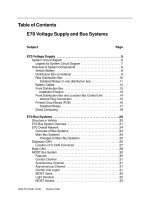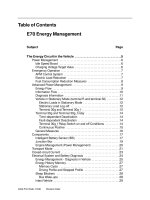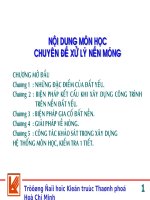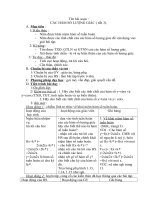C772 03
Bạn đang xem bản rút gọn của tài liệu. Xem và tải ngay bản đầy đủ của tài liệu tại đây (21.46 KB, 2 trang )
Designation: C 772 – 03
Standard Test Method for
Oil Migration or Plasticizer Bleed-Out of Preformed Tape
Sealants1
This standard is issued under the fixed designation C 772; the number immediately following the designation indicates the year of
original adoption or, in the case of revision, the year of last revision. A number in parentheses indicates the year of last reapproval. A
superscript epsilon (e) indicates an editorial change since the last revision or reapproval.
plasticizer bleed-out is not desirable. However, in some limited
instances, a controlled amount of plasticizer migration is
sometimes desired in order to improve the penetration of the
tape into the interstices of porous substrates. This test method
is designed to indicate whether or not a preformed tape sealant
exhibits oil or plasticizer migration and, if so, to what extent.
1. Scope
1.1 This test method covers a laboratory procedure that can
be used to determine the oil migration or plasticizer bleed-out
of preformed tape sealants.
1.2 The values stated in acceptable metric units are to be
regarded as the standard. The values given in parentheses are
for information only.
1.3 The subcommittee with jurisdiction is not aware of any
similar ISO standard.
1.4 This standard does not purport to address all of the
safety concerns, if any, associated with its use. It is the
responsibility of the user of this standard to establish appropriate safety and health practices and determine the applicability of regulatory limitations prior to use.
6. Apparatus
6.1 Vented Air Circulating Oven, that complies with Specification E 145 and is capable of aging samples at 70 6 2°C
(158 6 3.6°F) or 100 6 2°C (212 6 3.6°F).
6.2 Filter Paper,4 six sheets, high-grade, rapid, 76 mm (3
in.) in diameter.
6.3 Weight, 1 kg (2.2 lb).
7. Sampling
7.1 Select a fresh roll of preformed tape sealant at least 13
mm (0.5 in.) wide and 3 mm (0.125 in.) thick. Remove a
section of preformed tape sealant approximately 61 cm (2 ft)
long from the roll and discard it.
2. Referenced Documents
2.1 ASTM Standards:
C 717 Terminology of Building Seals and Sealants2
D 2203 Test Method for Staining from Sealants2
E 145 Specification for Gravity-Convection and ForcedVentilation Ovens3
8. Test Specimens
8.1 Prepare duplicate test specimens by cutting short lengths
of preformed tape sealant with the release paper still in place
and plying them together to form a solid pad having the
minimum surface dimensions of 38 mm (1.5 in.) by 38 mm and
3 mm (0.125 in.) thick.
8.2 Place each pad of preformed tape sealant on a piece of
filter paper with the release paper side up.
8.3 Ensure adequate contact between the preformed tape
sealant and the filter paper on each specimen by placing the
1-kg (2.2-lb) weight on top of the preformed tape sealant for 5
s.
3. Terminology
3.1 Definitions—The definitions of the following terms used
in this test method are found in Terminology C 717: preformed
tape sealant, sealant.
4. Summary of Test Method
4.1 The preformed tape sealant to be tested is placed on
filter paper. The specimen is heat aged and examined for
migration into the filter paper.
5. Significance and Use
5.1 Preformed tape sealants are tacky, deformable solids
that are used under compression between two substrates in a
variety of sealing applications. In general, oil migration or
9. Procedure
9.1 Place two additional pieces of filter paper under each of
these test specimens.
1
This test method is under the jurisdiction of ASTM Committee C24 on Building
Seals and Sealants and is the direct responsibility of Subcommittee C24.20 on
General Sealant Standards.
Current edition approved May 10, 2003. Published June 2003. Originally
approved in 1974. Last previous edition approved in 1997 as C 772 – 97.
2
Annual Book of ASTM Standards, Vol 04.07.
3
Annual Book of ASTM Standards, Vol 14.04.
4
This test method was based on the use of Whatman No. 1 filter paper. The sole
source of supply of the apparatus known to the committee at this time is Whatman
Inc., 9 Bridewell Place, Clifton, NJ 07014. If you are aware of alternative suppliers,
please provide this information to ASTM Headquarters. Your comments will receive
careful consideration at a meeting of the responsible technical committee,1 which
you may attend.
Copyright © ASTM International, 100 Barr Harbor Drive, PO Box C700, West Conshohocken, PA 19428-2959, United States.
1
C 772 – 03
10.1.5 For each specimen, whether there is any evidence of
stain, oil migration, or plasticizer bleed-out on the first filter
paper directly under the pad of tape compound.
9.2 Place each of these tape-filter paper assemblies in an air
circulating oven maintained at 70 6 2°C (158 6 3.6°F) and
condition them for 3 weeks at this temperature. (Alternatively,
samples can be conditioned for 1 week at 100 6 2°C (212 6
3.6°F).
9.3 Examine the filter papers under each specimen for
evidence of oil migration or plasticizer bleed-out as soon as
possible after removal from the oven. The filter paper should be
viewed from the back side when held up to a light.
NOTE 1—Care should be taken not to confuse the changes in filter paper
color or opacity due to being in direct contact with the tape with evidence
of oil migration or plasticizer bleed-out.
10.2 A stain index can be determined for any one specimen
by adding the average distance of the stain and the number of
filter papers stained. (See Test Method D 2203.)
10. Report
10.1 Report the following information:
10.1.1 Identification of the preformed tape sealant, that is,
the name, lot number, and any other identifying characteristics.
10.1.2 Oven aging conditions used for this test.
10.1.3 For each specimen, number of filter papers stained or
that show evidence of oil migration.
10.1.4 For each specimen, to the nearest 0.3 mm (0.01 in.)
the average distance of the stain from the edge of the pad of
tape on the filter paper that was in direct contact with the pad
of tape compound.
11. Precision and Bias
11.1 Two round robins were conducted using this procedure
and a variation wherein ultraviolet lights were also used as a
heat source. Different laboratories showed excellent comparative results when ranking the relative oil migration of tape
samples using this type of procedure.
12. Keywords
12.1 oil migration; plasticizer bleed; preformed tape sealants; tapes; tape sealants
ASTM International takes no position respecting the validity of any patent rights asserted in connection with any item mentioned
in this standard. Users of this standard are expressly advised that determination of the validity of any such patent rights, and the risk
of infringement of such rights, are entirely their own responsibility.
This standard is subject to revision at any time by the responsible technical committee and must be reviewed every five years and
if not revised, either reapproved or withdrawn. Your comments are invited either for revision of this standard or for additional standards
and should be addressed to ASTM International Headquarters. Your comments will receive careful consideration at a meeting of the
responsible technical committee, which you may attend. If you feel that your comments have not received a fair hearing you should
make your views known to the ASTM Committee on Standards, at the address shown below.
This standard is copyrighted by ASTM International, 100 Barr Harbor Drive, PO Box C700, West Conshohocken, PA 19428-2959,
United States. Individual reprints (single or multiple copies) of this standard may be obtained by contacting ASTM at the above
address or at 610-832-9585 (phone), 610-832-9555 (fax), or (e-mail); or through the ASTM website
(www.astm.org).
2





![MAKE magazine [OH] 03](https://media.store123doc.com/images/document/13/ce/fj/medium_fjg1388298702.jpg)



